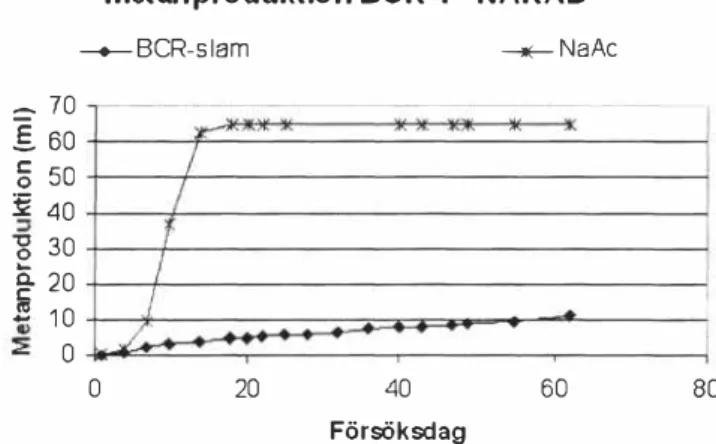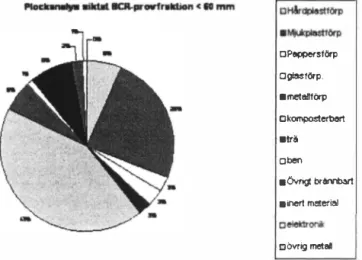40 Kalmar ECO-TECH '05 and
The Second Baltic Symposium on Environmental Chemistry KALMAR, SWEDEN, November 28-30, 2005
TREATMENT OF MSW IN
A BIOCELLREACTOR
Dan Waldemarson
Norra Asbo Renhallnings AB, Sweden
ABSTRACTAt Hyllstofta waste treatment plant municipal solid waste (MSW), pre-treated biodegradable industrial and sludge are treated in biocellreactor (BCR),
1. METHOD
A 6000 m2 big area was built with a bottom layer of a Im thick layer of clay with a permeability < I 0-10, The clay is cowered I m sieved course till, In the top of the till layer there are 4 drainpipes I course gravel, The top surface is built with slope against the drainpipes,
MSW and biodegradable industrial waste are crushed and mixed together with biodegradable sludge, The mix is placed in 70 m long, 10 m broad and 8 m high piles, IO piles were placed beside each other on the prepared area, The first pile was built up against a wall of soil on two sides, The next pile has is built next to the first one and has a soil wall only in the far short end, When the pile is about 6 m high we start to build pile number two and a gas drainpipe is dug about I m into the waste (Figure 1), About 50 cm under the top of the pile a perforated pipe was dug for recycling of leachate, Each pile is covered with plastic foil which is covered with paper mill sludge to prevent the wind to blow away the plastic foil,
Metanproduktion BCR 5 - NARAB
--scR-slam -NaAc - 80 §, 70 C 60-i
50�
_g 40 £ 30g-
20i
10-
�
r
____..,-I
?
I
✓
'A
I
I �
,_, £ I :E D -0 10 20 30 50 60 ForsoksdagFigure J, Activity and digestion test of the organic sludge in BCR 5,
167 https://doi.org/10.15626/Eco-Tech.2005.017
Kalmar ECO-TECH 'OS and
y
The Second Baltic Symposium on Environmental Chemistr KALMAR, SWEDEN, November 28-30, 2005
The leachate is collected and recycled into the cell. Gas are collected by under pressure of 0,6 bar in the cell.
2. PURPOSE
The purpose of the project is to digest the biodegradable part of the waste and make the MSW biologically stable with a cheap process with low investment costs.
3. HYPOTHESIS
After 4-5 years in the BCR all the biodegradable waste is digested and no more gas of commercial interest is possible to collect and the waste is biologically stable after 3-4 month of composting. The weight loss due to gas disposal is 25 %- 30 % of the initial weight After sieving, 30-40 % of the initial weight can be disposed as fuel, 20 % can be used as soil and 10 % will be placed in the landfill. The recycled leachate should promote favourable conditions in the cell and the gas potential in the leachate is used in the cell.
4. RESULTS
The gas production starts within a month after the cell is sealed. The gas production varies within a great range. When building the first cells we tried different techniques. From cell 4 the techniques was established and the gas collection varies from about 40 m3/ton to 110
m3/ton or from 220 m3/ton VS to 720 m3/ton VS.
The best cell so far is number 4. This cell was sealed in the January 2002 and still produces gas. A laboratory test of the organic mater from this cell shows that there is very little gas potential left and that the waste is biologically stable (Figure 2). Cell number 5 is 5 months younger than cell 4 has produced about half as much gas and has a lot of gas potential left
(Figure 3), but does not produce any gas of interest due to high oxygen content
Metanproduktion BCR 4 - NARAB
--BCR-slam
-lOE-NaAc ::::-- 70.S
60 § 50 � 40'8
30 ii 20!
10 0 0 20 40 60 80 ForsoksclagFigure 2. Activity and digestion test of the organic sludge in BCR 4.
Kalmar ECO-TECH ·05 and
The Second Baltic Symposium on Environmental Chemistry KALMAR SWEDEN, November 28-30, 2005
Plock.:1g1�s sikt.lt BCR-tirov >60 mm vlkt �-, CO% ■0% 09% □Hirdp!as!fOrp ■Mjukplssttorp ol'sJJpers«irp a�10rp. ■metaliOrp CkOll'qXlslerbart ■tril Oben ■Ovrigt brambert ■11""1 matensl Oelet<!ronic QO'lrig metell 00% ■4%
Figure 3. Hand-pick analysis of the material from BCR 1 (sample fraction >60mm).
Cell number I was opened in august 2004 and 300 tons of the material was dug out. There was no problems with gas emissions or bad smell. The material was pile up and a compost process started at once. The temperature in the compost exceeded 60.°C within two days stay high for about two month. When the material was composted it was sieved first a 60 mm drum sieve and secondly in a 40 mm sieve. The three different fractions were analysed
(Figure 4). The material exceeding 60 mm consists of 60 % burnable material, 30% compost
and 10 % inorganic material. The fraction between 60 mm ·and 40 mm consists of 49 % burnable,43 % compost and 8 % inorganic material. The fraction smaller than 40 mm consists on about 75% organic material and 20 % inert material and 5 % of plastics. Al of the waste put into the cell was recycled as gas, fuel or usefull organic matter.
OPappersfOrp CglastOrp.
■
melallfOrp Ckompostert:>art ■Ir& oben •Ovrigt briimbart •inert meteri!>I aovrlg metalFigure 4. Hand-pick analysis of the material from BCR l (sample fraction <60mm).
Kalmar ECO-TECH '05 and
The Second Baltic Symposium on Environmental Chemistry KALMAR, SWEDEN, November 28-30, 2005
The leachate is collected in the drainage system and recycled into the BCR, The leachate is pumped into one cell for a week and then we shift to the next cell.
The leachate composition has varied a lot from the start
November 2001 23 000 mg/I ofCODc,, 3500 BOD1 and 1800 NH4-N September 2003 12 000 mg/I of CODc,.,2100 BOD1 and 1500 NH4-N November 2003 2600 mg/I of CO De,., 800 BOD1
Maj 2005 7000 mg/I ofCODc,, 2600 BOD1 and 2600 NH4-H
The temperature in the cells varies between 30.°C and 50_°C with a higher temperature in the upper parts of the cell. This could be due to leakage of air into the cell due to the lower pressure in the cell which promote composting of organic matter.
5. DISCUSSION
It is obvious that it is possible to reach a complete digestion of the MSW in less than 4 years if the conditions in the BCR is favourable.
We have stopped sucking gas out of some cells due to high amount of oxygen in the gas and in some cells the gas flow has disappeared, We believe that these problems are due to settling of the waste. The settling of the waste might course breakage of the gas pipe or breakage of the plastic foil covering the cell letting the air into the cell. We think that these problems are possible to overcome by some more testing. Unfortunately the environmental authorities in Sweden have band this method so Narab can not go on developing the BCR technique,

